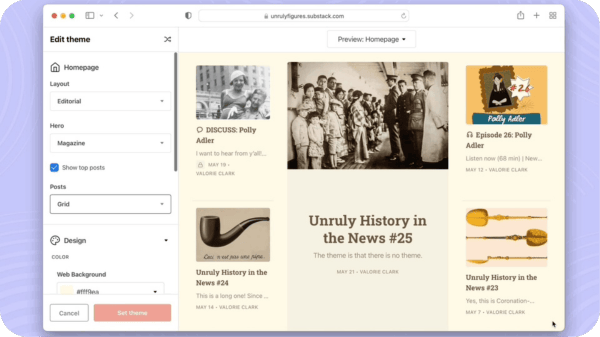|
|
It's Friday and if you're on the hunt for Bigfoot, you should probably check out the Unicode Consortium's latest batch of emojis. (Who knows—you might just find the big guy lurking there under a pseudonym.) |
|
Today's News |
💸 Substack snags $100M 🏛️ Shorts avoids getting political 👀 Fortnite upsets Squid Game fans 🌎 Countries pay iShowSpeed to visit 📹 A new AI manipulates video in real time
|
|
|
|
MONEY MOVES |
|
Substack just landed a $100M investment |
The platform: Substack was one of the first platforms to cater to the growing community of newsletter writers. In the eight years since its 2017 launch, the company—which is led by Co-Founders Hamish McKenzie, Chris Best, and Jairaj Sethi—has transformed into a multimedia hub complete with varied revenue streams, a native video player, and tools for marketers. |
A recent update heightened Substack's similarities to Twitch and TikTok by bringing more discovery to live videos—and now, the newsletter platform is leveling up once again with a fresh infusion of funding. |
The funding: Substack has announced a $100 million Series C funding round that values the company at more than $1.1 billion and will be used to develop and upgrade the platform's suite of features. Investors at BOND and The Chernin Group led the round, which will install BOND partner Mood Rowghani on the Substack board. Other participants included Andreessen Horowitz, LeBron James' agent Rich Paul, and SKIMS Co-Founder Jens Grede. |
In a blog post announcing the Series C round, Substack pledged to continue uplifting its base of independent newsletter publishers, which now collectively reaches over five million paying subscribers: |
"We'll invest in better tools, broader reach, and deeper support for the writers and creators driving Substack's ecosystem. Already, hundreds of millions of dollars flow from audiences to creators there every year…But this is just the beginning." | | | | - Substack |
|
|
The context: Substack's investment in creators comes at a time when newsletter platforms are drawing widespread interest from VC firms. McKenzie, Best, and Sethi's company has already deployed capital to woo creators away from competitors like beehiiv (which raised $33 million of its own in 2024). For example, Substack recently launched a $20 million fund that rewarded newsletter authors who brought their built-in audiences to the platform. |
|
HEADLINES IN BRIEF 📰 |
|
|
|
CREATOR CONTROVERSY |
|
Fortnite made a deal for Squid Game rights. Then it deleted fan projects. |
The deal: Earlier this week, we wrote about a new Roblox initiative that gives devs the legal A-OK to make games based on IPs like Squid Game, Twilight, and Saw. Now, Fortnite has arranged a similar deal with Netflix, which will allow creators to make games/experiences based off Squid Game. |
Unlike Roblox's initiative, however, Fortnite's deal seems to have kicked off on a sour note. While pre-existing fandom-based games like Blue Lock: Rivals have so far survived the introduction of Roblox's IP platform (and are likely to benefit from the additional security granted by it), Fortnite has taken a very different approach to fanmade projects on its own platform. |
The snag: After the deal was sealed between Fortnite and Netflix, fans who'd already made and published Squid Game-themed islands (including the creators of smash hits like Squid Guys and Octo Game 2) saw their projects deleted. |
That's because while Netflix has now agreed to let creators build islands based on Squid Game, those creators are not actually allowed to publish anything until August 14—almost two full months after the show's third (and final) season is set to premiere. |
In other words: creators of existing games that ue the IP effectively have a two-month ban, if Netflix lets the islands come back online at all. (So far, it's unclear if the streamer will only grant approval to new games.) |
The impact: An Epic Games spokesperson told Digiday that the August 14 start date was deliberately chosen to give creators time to build islands before the release of Squid Game assets. They added that Epic has "heard feedback" about creators' concerns, and plans to lift publishing holds earlier for future IP deals—but the damage may already be done. |
As Digiday notes, this crackdown has made devs nervous about building fandom-based projects. Creators like Tom Jank, for instance, told the outlet this situation has made them want to focus entirely on their original IP in order to avoid the risk of takedowns. |
|
THE BIZ |
|
Want more tourists in your country? Pay IShowSpeed to come visit. |
The tour: IShowSpeed is currently on a world tour, taking his 42 million YouTube subscribers, 38 million Instagram followers, and 1.1 million Twitch followers to major countries around the globe. The resulting viewership numbers have been striking: a recent stream from Turkey, for instance, attracted ~437K concurrent viewers on YouTube and ~48K on Twitch, making Speed the most-watched live creator on both platforms simultaneously. |
With that kind of reach, the creator's streams are likely to inspire at least a few tourists to book similar trips—so, with that in mind, countries are paying Speed to stop by. |
According to LRT, Lithuania, Latvia, and Estonia have already paid the creator €30,000 each (around ~$35K USD), with €20,000 going into Speed's pockets and the other €10,000 funding logistics during his stays. |
For the most part, those payments are taxpayer-funded and disbursed through regional tourism efforts. In Lithuania, for example, Speed's visit was arranged for and paid by official tourism promotion agencies Go Vilnius and Travel Lithuania. |
These agencies say incentivizing visits from influencers like Speed is part of the constant battle for tourism dollars—and so far, those investments seem to be paying off. According to Kaarel Kõvatu (who serves as Tourism Marketing Project Manager at Estonia's Entrepreneurship and Innovation Foundation), Speed's July 15 stream in Estonia snagged nearly 2 million viewers. |
The takeaway: Those kinds of viewership numbers may or may not translate into clear tourism boosts for contributing countries. But regardless of how the final stats shake out, there's no denying the significance of entire regions courting a single streamer. As the digital economy continues to mature, it's clear that the influence of creators is growing fast. |
|
WATCH THIS |
|
What if streamers could manipulate live video in real time? |
The video-to-video model: Decarte's newly-launched Mirage AI could be the answer to that question—and a potential game-changer for streamers. The company claims that Mirage is the "first ever World Transformation Model" and is capable of "turning any video, game, or camera feed into a new digital world, in real time." |
If those claims hold true (and Mirage is able to overcome the typical hurdles that come with launching creator-focused tech), streamers on platforms like Twitch and YouTube could soon have the ability to manipulate live footage and generate on-screen characters, backgrounds, and more in real time. |
Check out a demo for the tool here. |
|
Was this email forwarded to you? Subscribe here. |
Want to introduce your brand to Tubefilter's audience? Sponsor the newsletter. |
|
Today's newsletter is from: Emily Burton, Drew Baldwin, Sam Gutelle, and Josh Cohen. |







